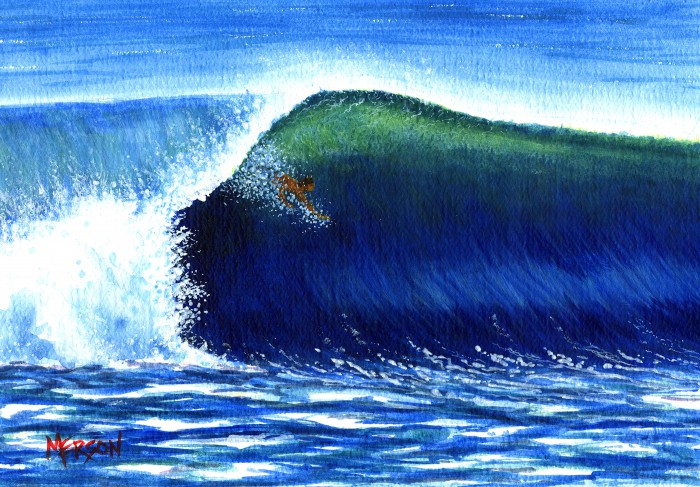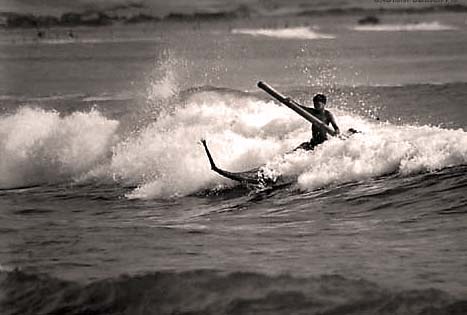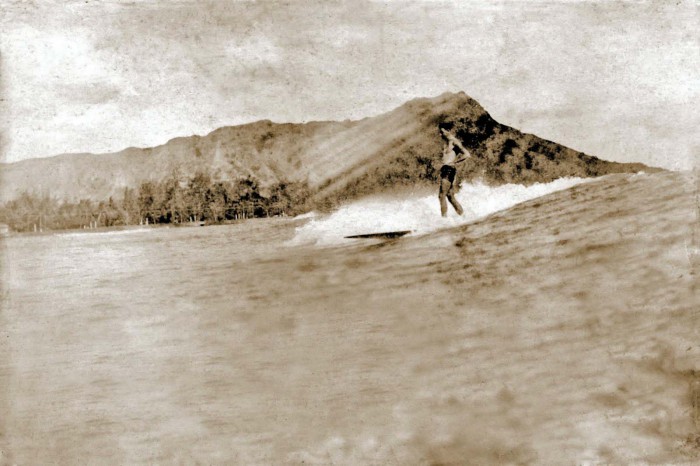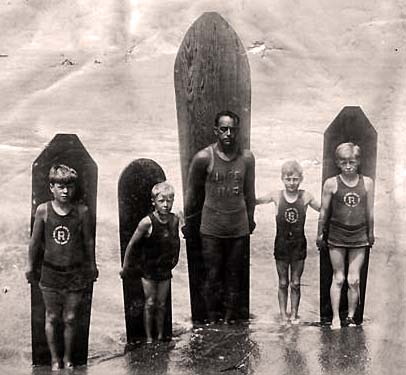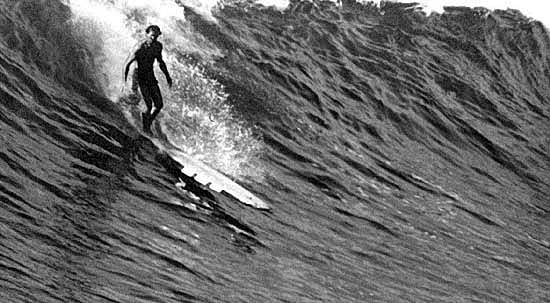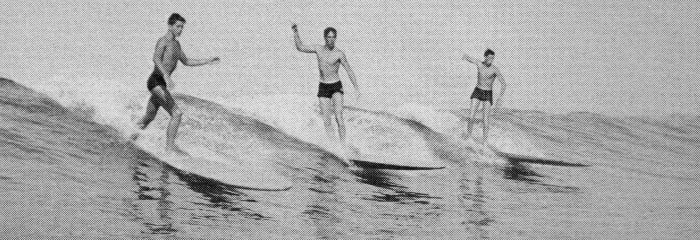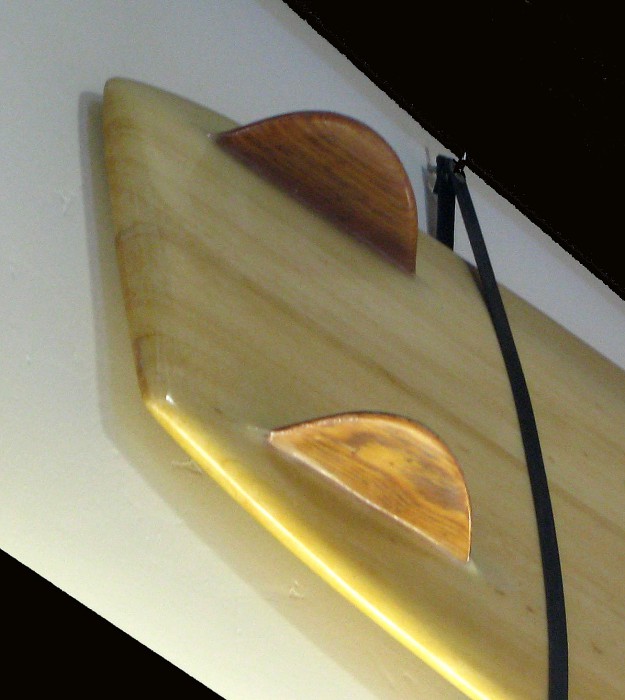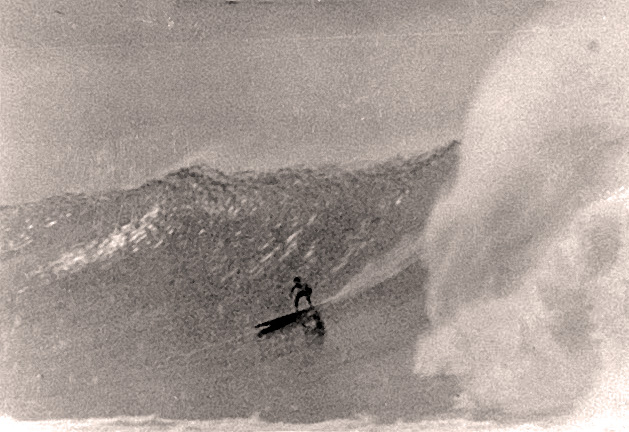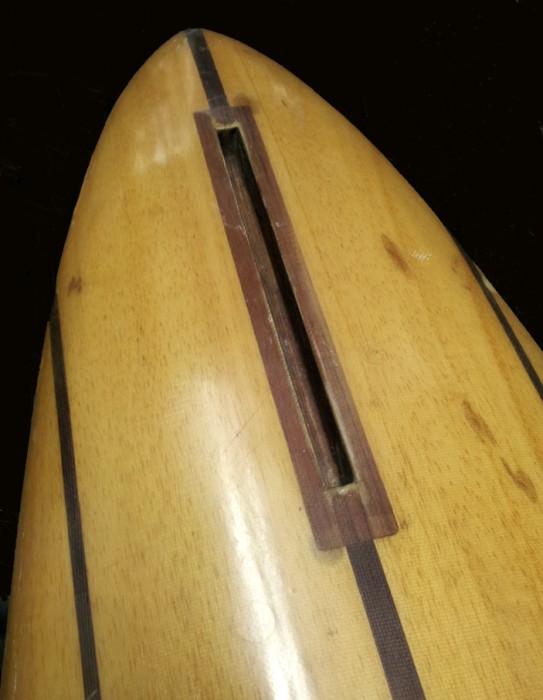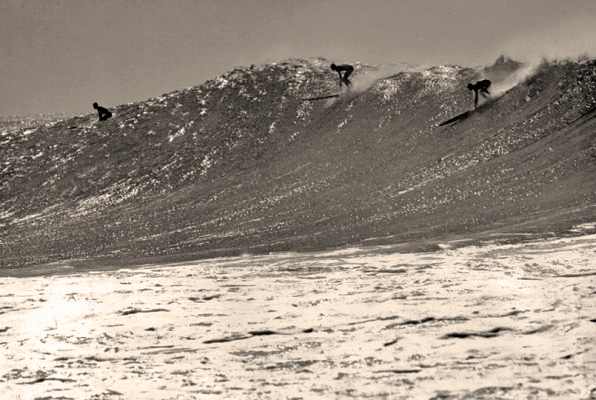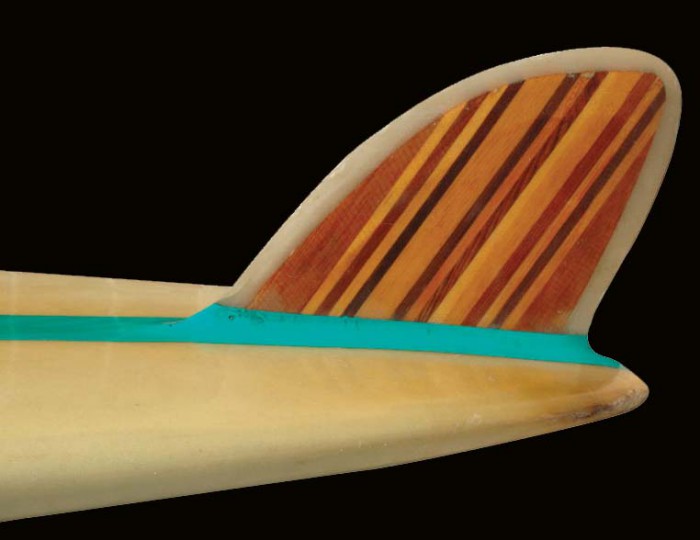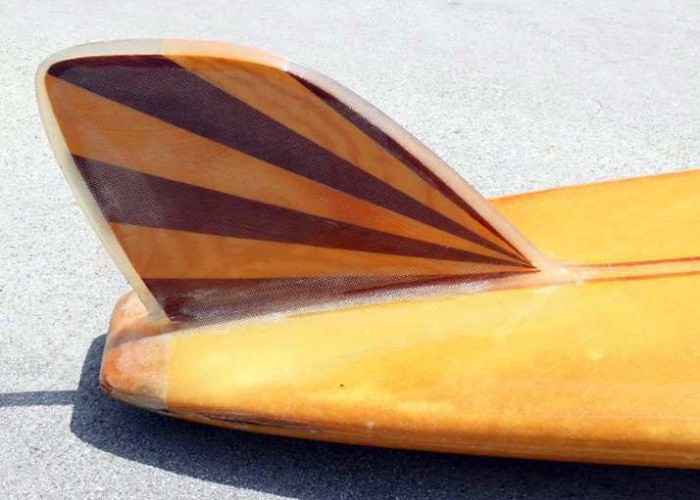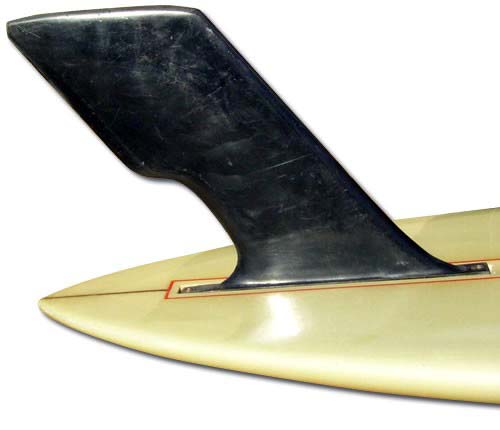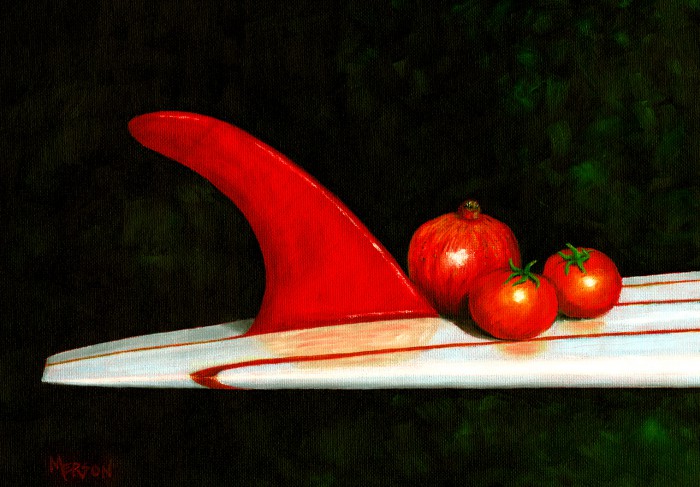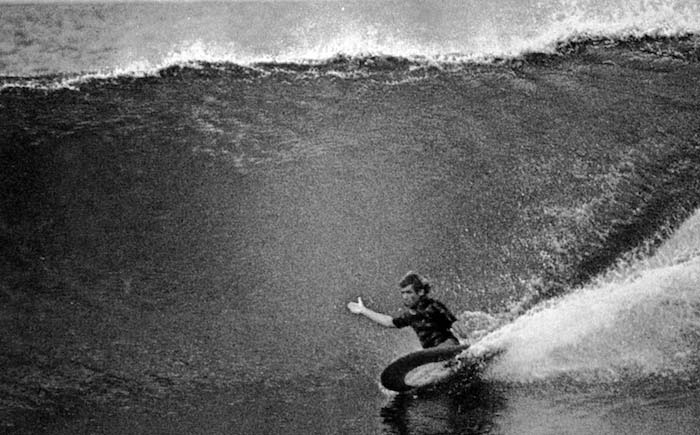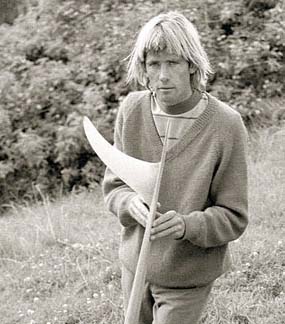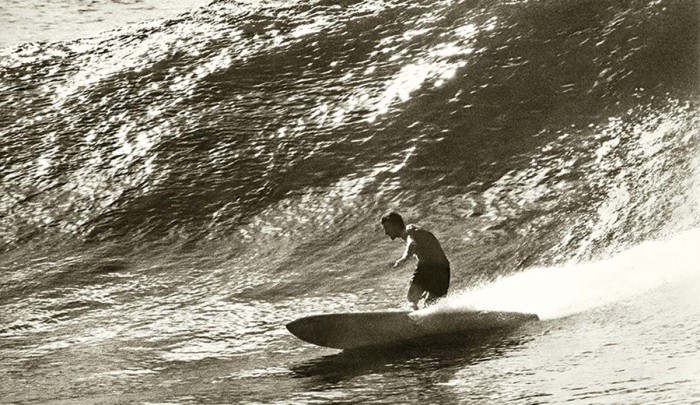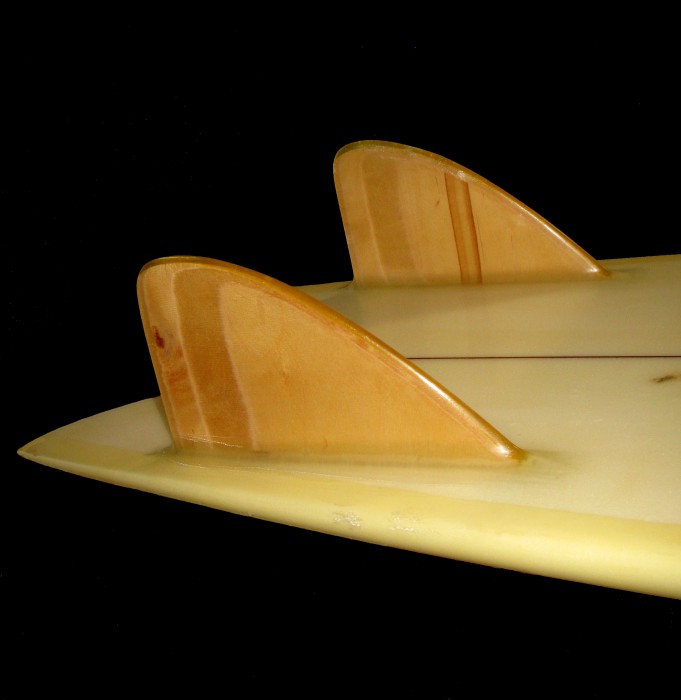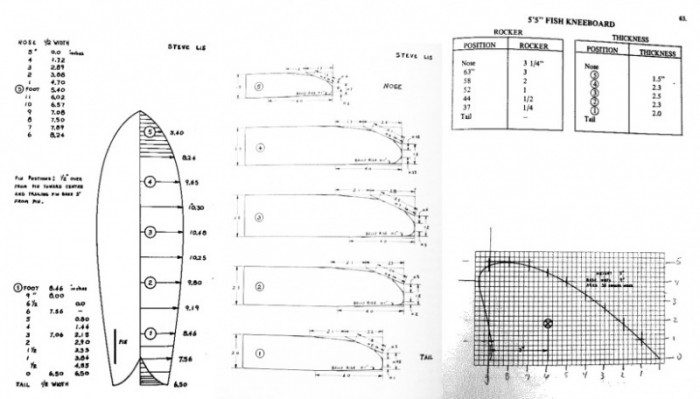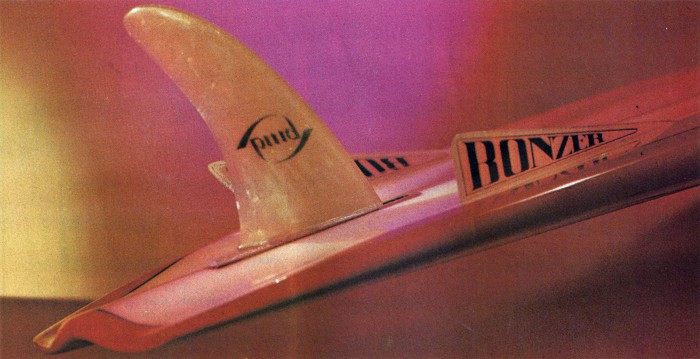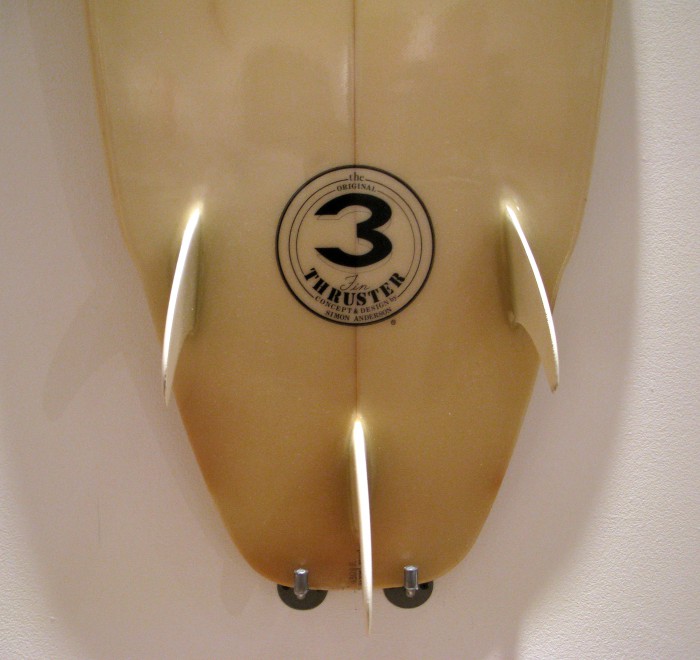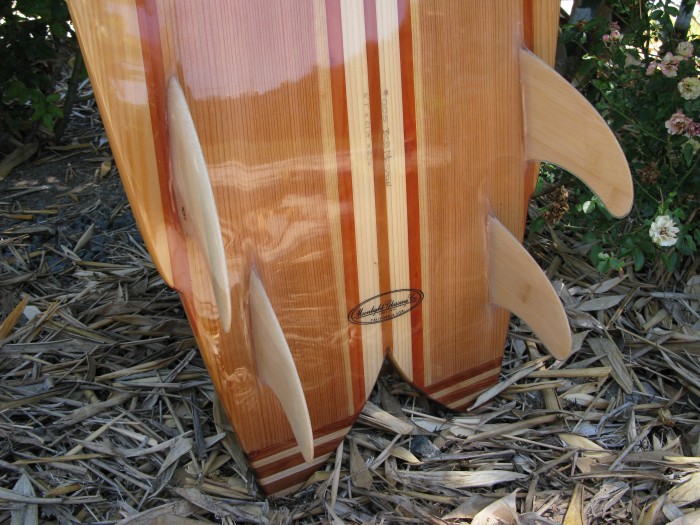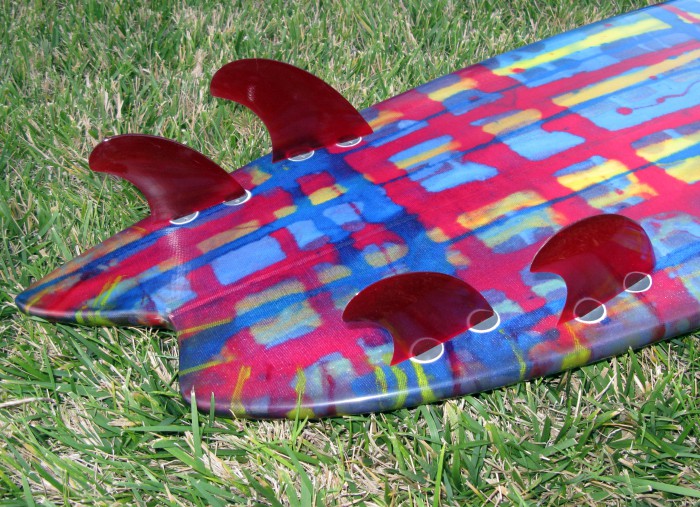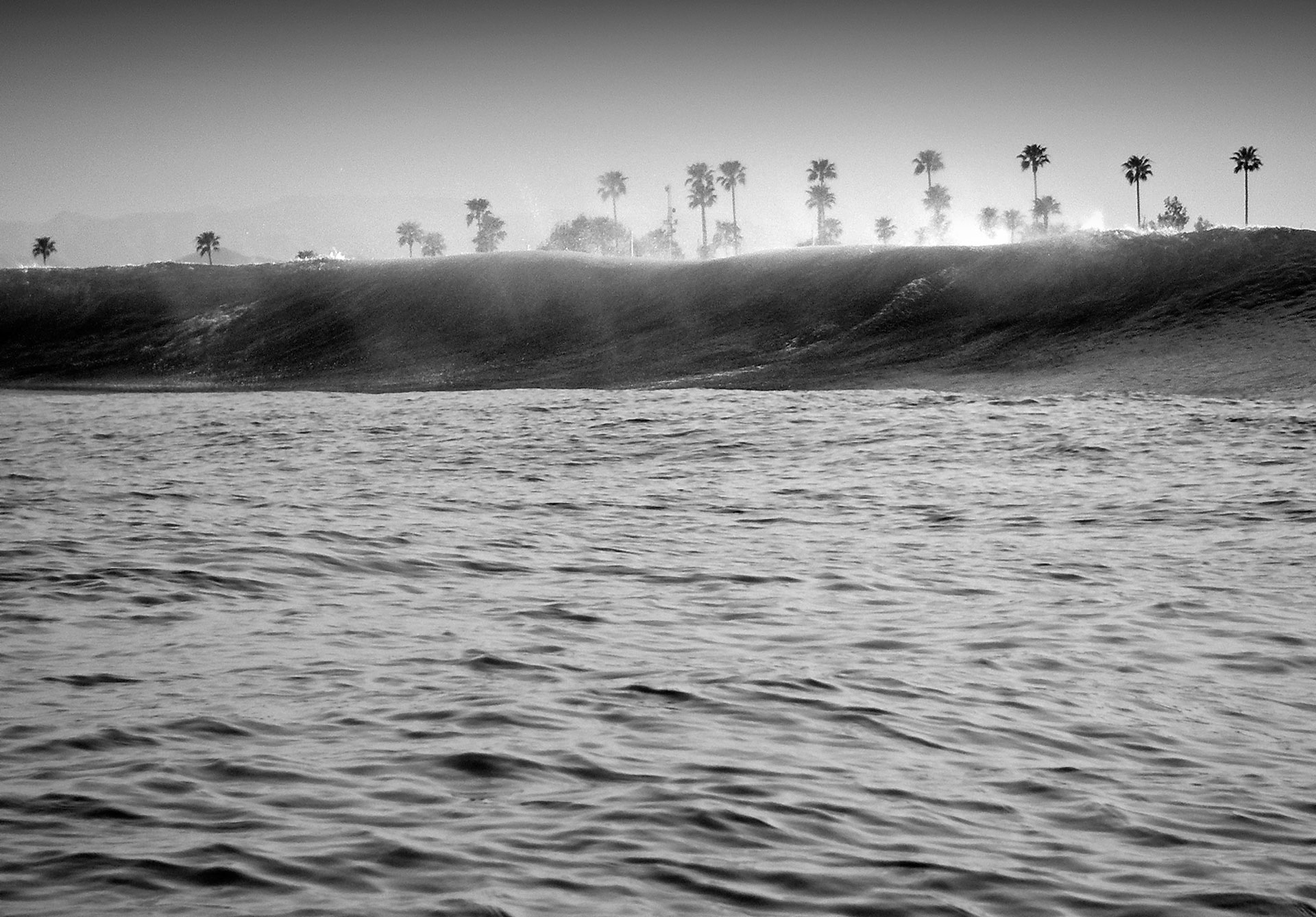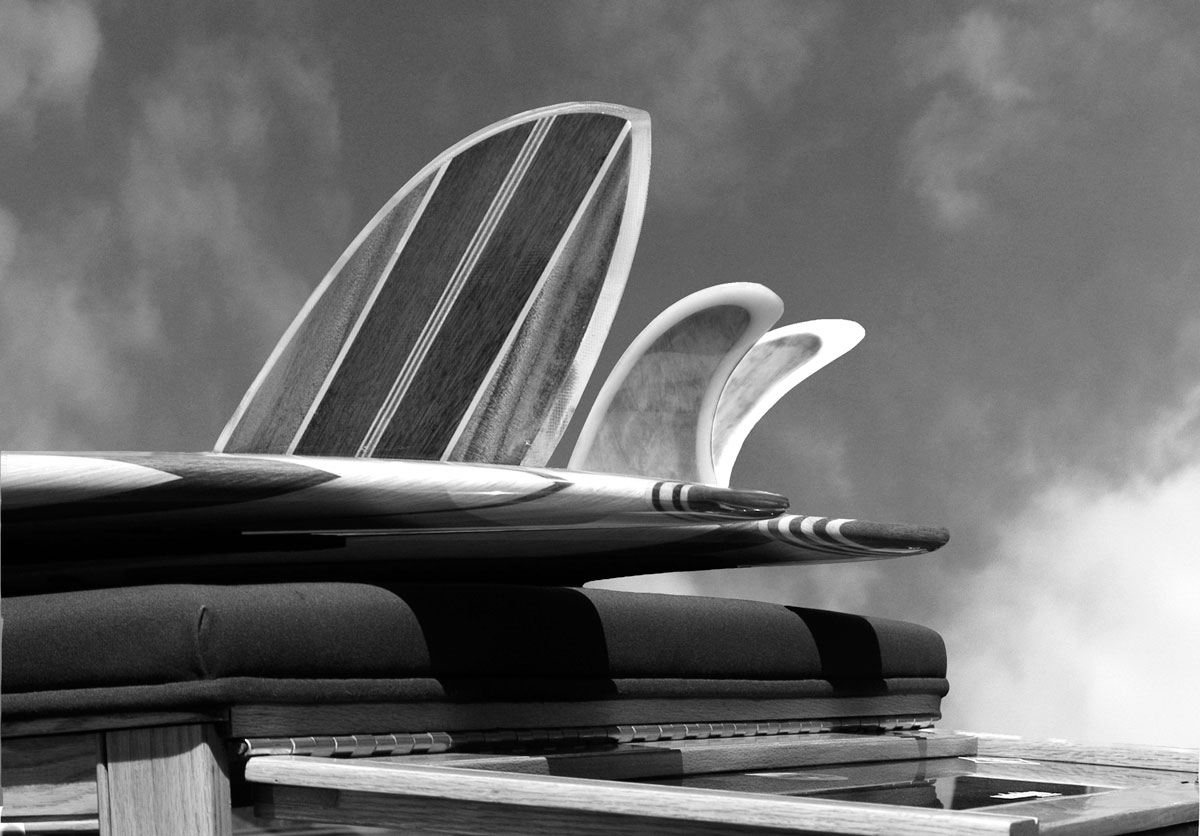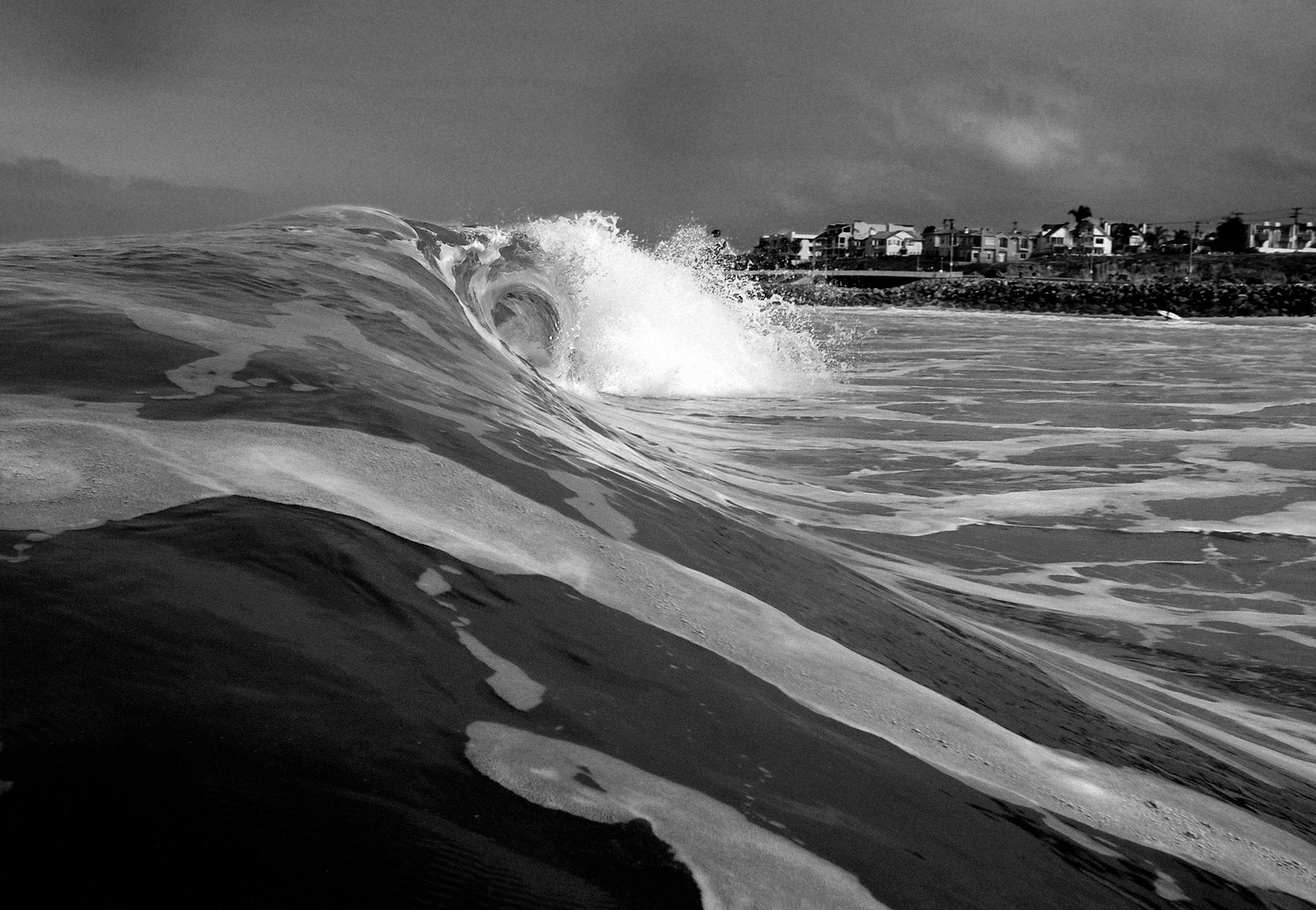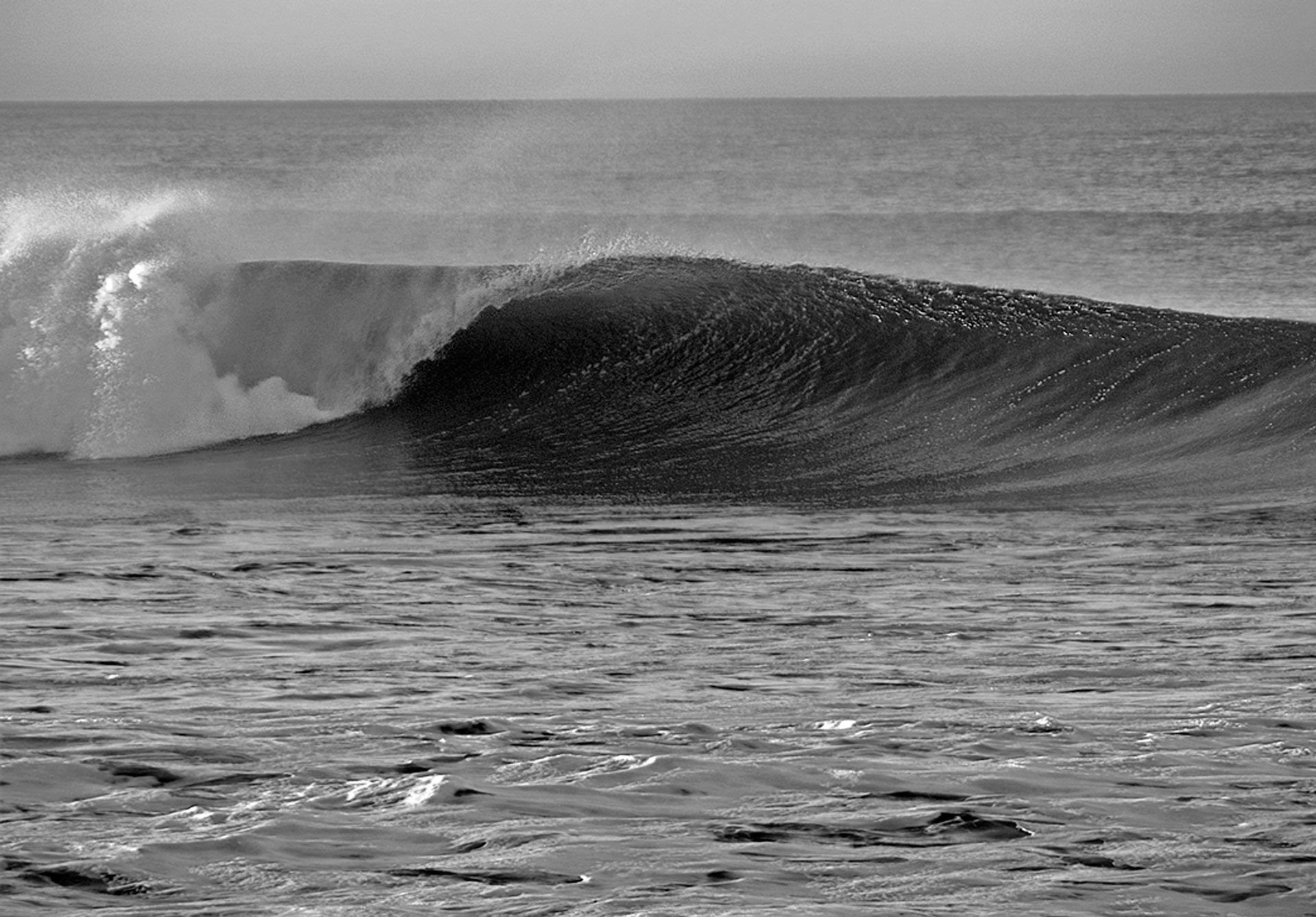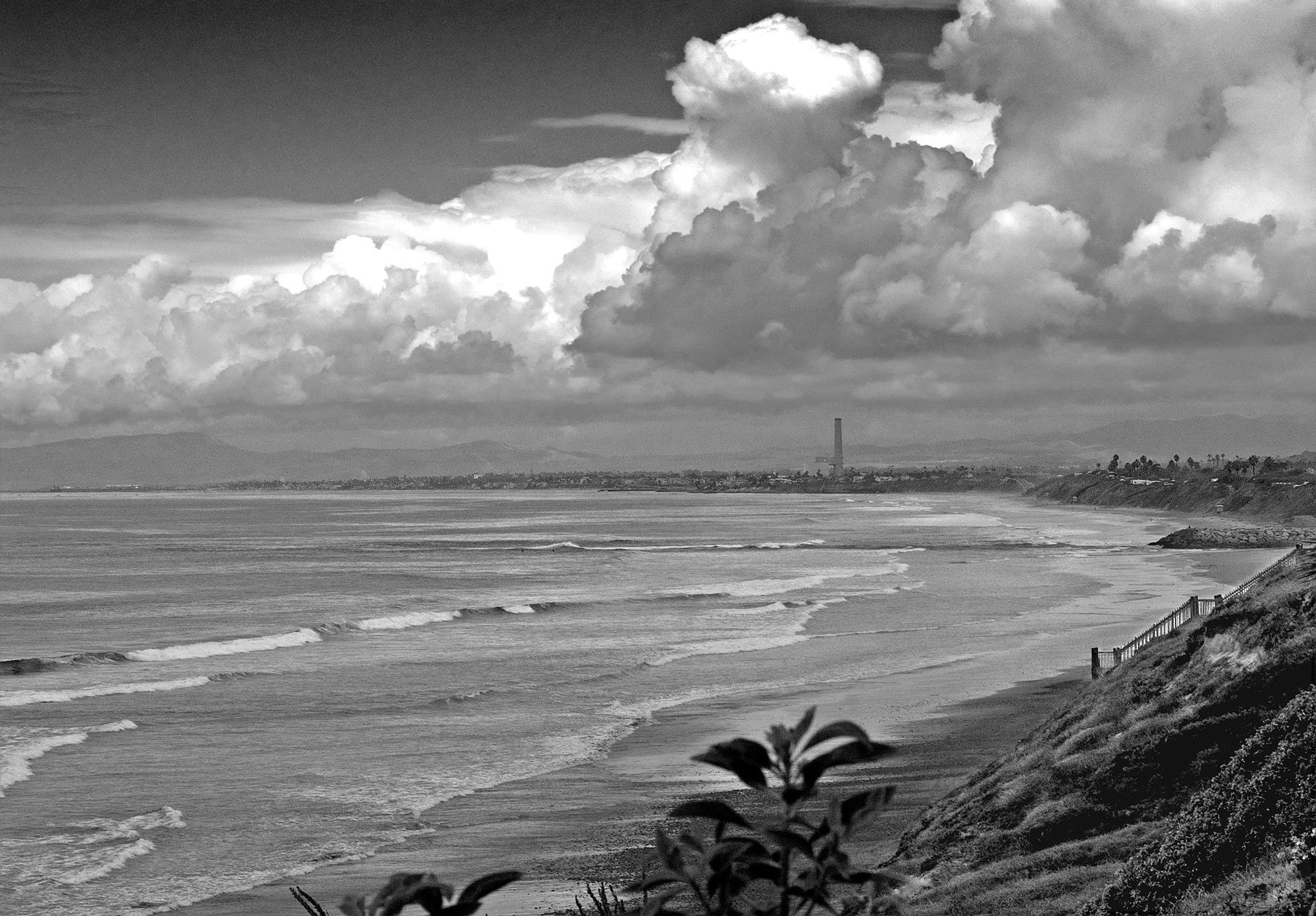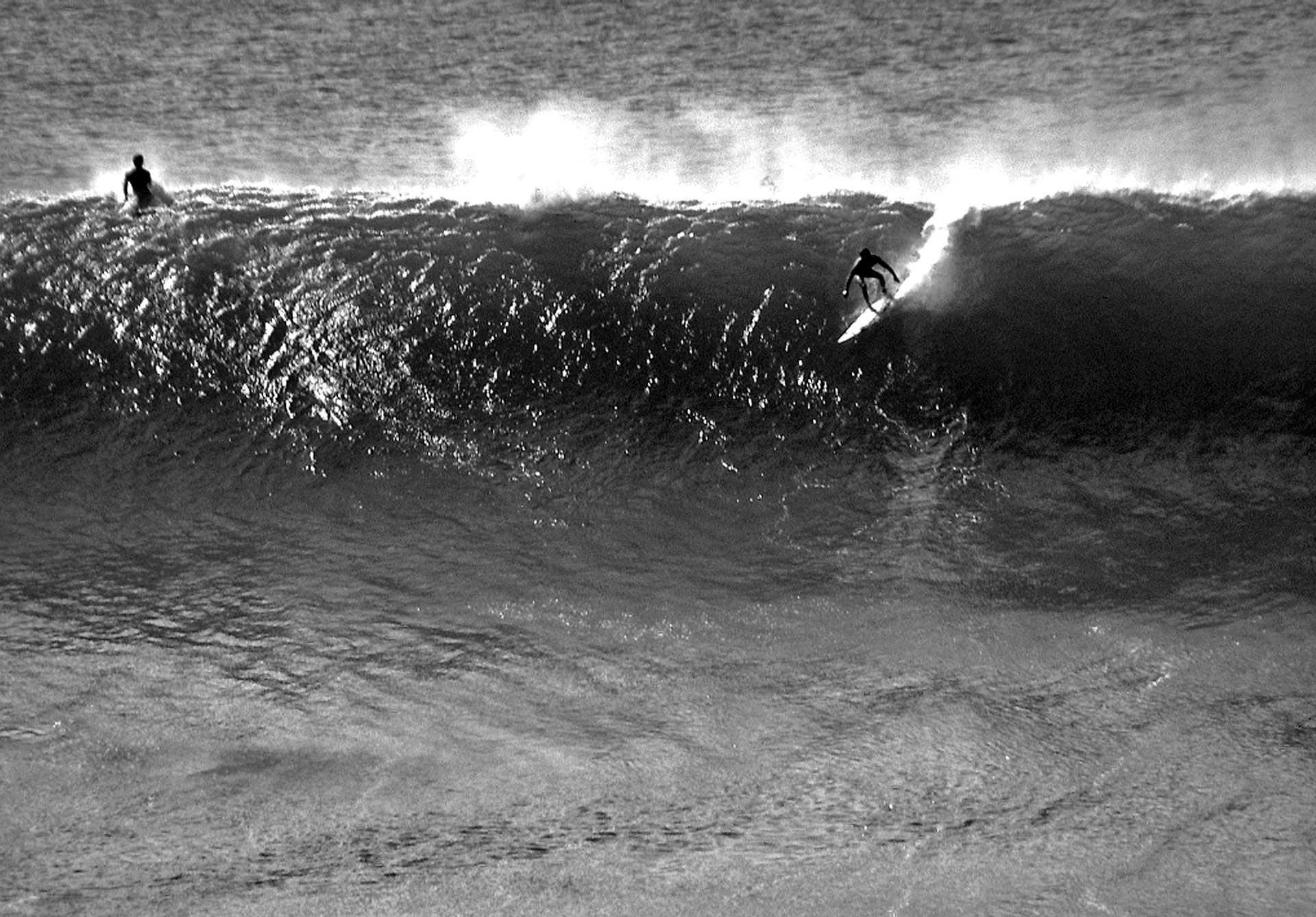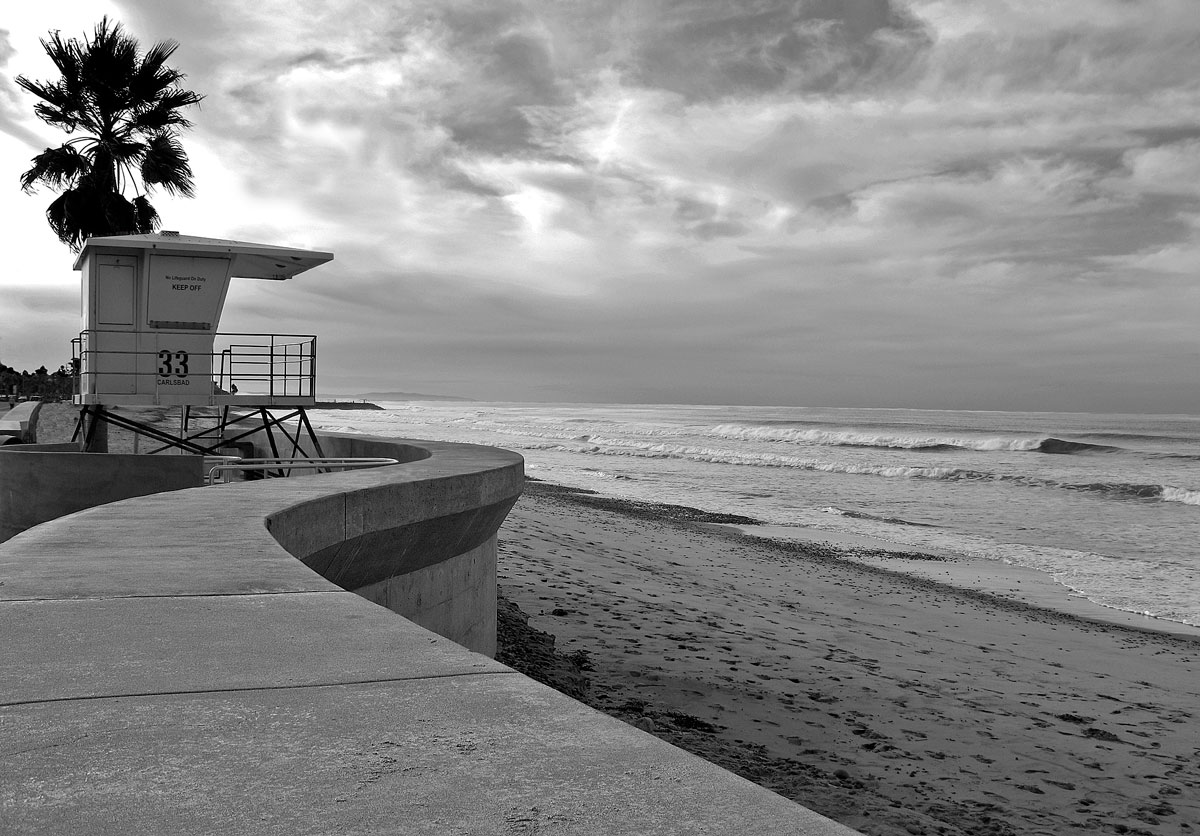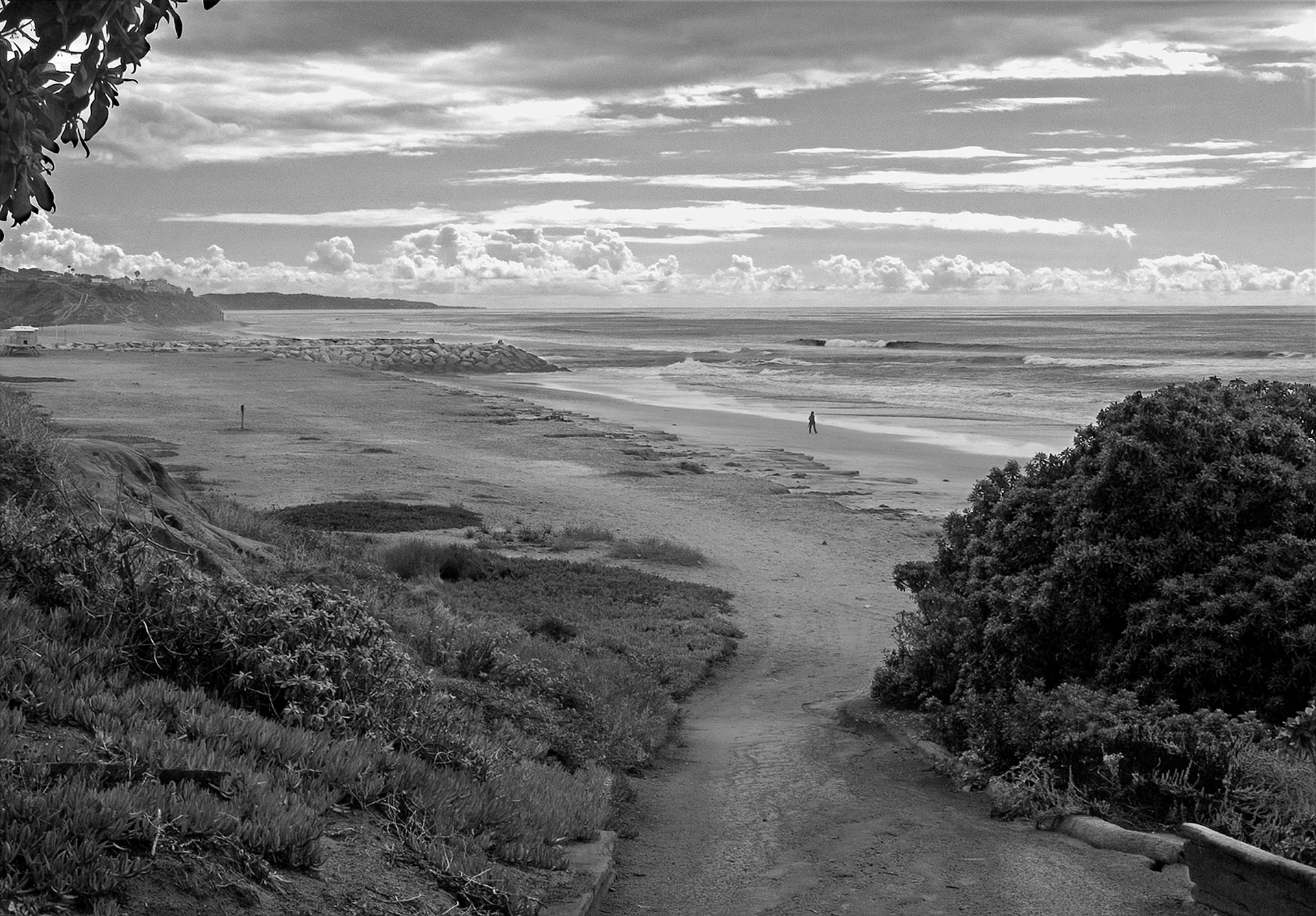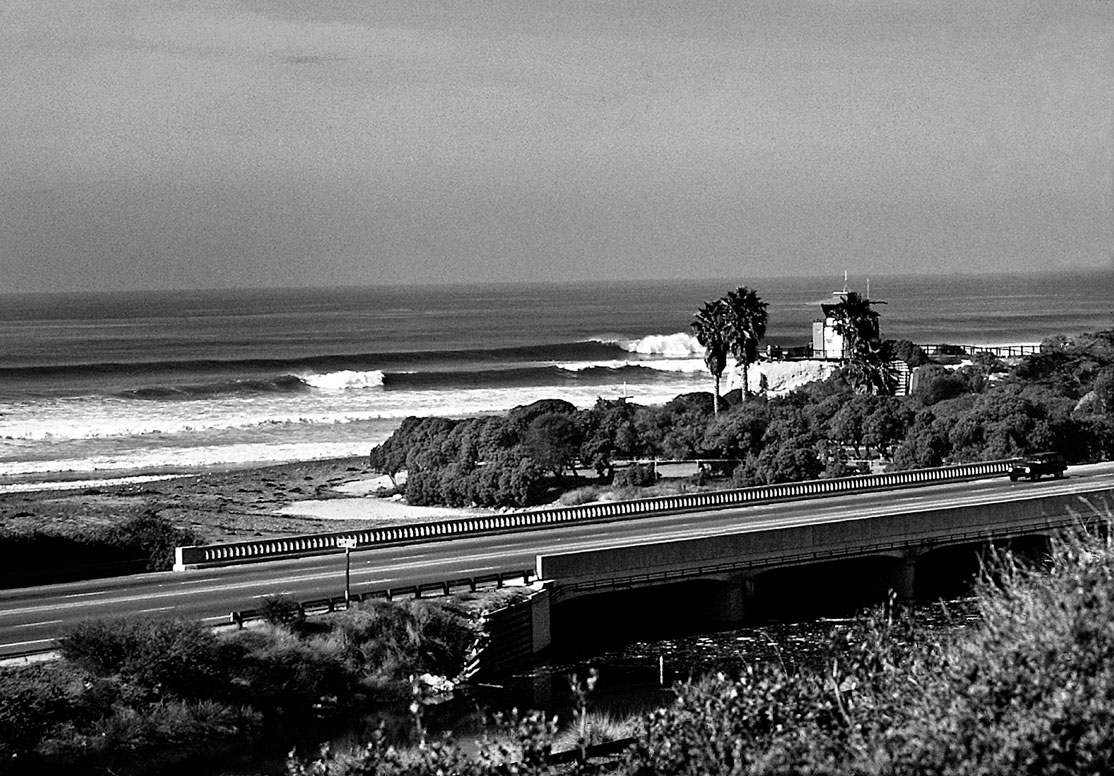History
An abridged history of the surfboard fin.
No one knows when surfing started. It could have been the first time man entered the ocean out of curiosity or perhaps looking for diner. As he stood in waist deep water marveling at the fish and kelp he was pulled at first into deeper water and then elevated by a thick fast moving liquid wall. He was pitched forward and upward and then down toward the churning bottom. He bounced off the sand and was washed up by the foaming white water and deposited on the beach. After he shook the sand out of his ears and eyes he realized that what had just happened to him was amazing. The first body surfer stood up and walked back out into the sea.
The first surf craft is thought to be the small reed fishing boats used by ancient fishermen along the coast of Peru. These watercraft were developed over 3000 years ago as a method to get out past the breaking waves and catch more fish. After a successful day on the water the first fishermen were pleased with their new craft until they started back toward shore and were pounded by the waves.
Losing the days catch gave them reason to modify their boats to make them more seaworthy and able to ride the waves into the beach. A bamboo pole was used as a paddle and also a rudder to steer the small craft. As they progressed with the development of their craft and gained experience handling the small boats in the surf, riding the waves back to shore soon became the best part of the day.
The first surfboards were developed by the Polynesians and became very popular in Hawaii during the 18th century. The boards ranged in size from 7’ to over 20’ in length often weighing well over 100 pounds. The boards were hewn from native trees such as Koa, Wili Wili and Ulu.
They had flat bottoms and wide tails. The challenge from the beginning was to make the board go where the rider wanted it to go. If you didn’t want to go straight you were very disappointed because these early boards only went in one direction.
The first major modification to the solid wood surfboard happened in the early part of the 20th century when a young George Freeth decided to take up the ancient sport of surfing. He disliked his 16’ board from the start and eventually cut it in half to make it more manageable. George’s new board was the talk of the Hawaiian beach scene and soon the sawdust was flying as the locals jumped on the next big thing.
Even though the boards were smaller and somewhat lighter they would not turn and only went straight to the beach. George Freeth was the first professional surfer. He was hired by Henry Huntington and shipped off to California to give surfing exhibitions in Redondo Beach to promote Huntington’s Pacfic Electric Railway. George has been referred to as the Father of Modern Surfing and given credit along with Duke Kahanamoku for surfing’s rise in popularity.
The next important design change came in 1929 by Tom Blake. He was frustrated with the traditional, hard to handle, heavy solid wood Hawaiian boards. Tom invented a radical new board that was hollow. Although this new board was 15’ long and weighed close to 100 pounds it worked much better than the solid boards.
After some refinement he shortened the boards and got them down to around 40 pounds. At first it was ridiculed by the surfing establishment of the day, but after seeing how fast it was and the ease with witch it planed across the water, the hollow board became very popular. The board had boxed rails, a flat bottom and a narrow pin tail but it was still ridden pretty much straight into the beach. The boards paddled fast and Blake won many paddleboard races with his new design. In 1931 Tom’s hollow board became the first mass produced surfboard/paddleboard. Tom also is credited with the first surf book “Hawaiian Surfboard” and also as the first surf photographer.
The evolution of the surfboard continued in 1934 when a group of Hawaiian surfers, Wally Frosieth, John Kelly and Fran Heath were inspired by Tom Blake’s design and decided to take things into their own hands. They dramatically changed the tails of their old solid wood boards. They narrowed the nose and tail, modified the rails and shaped the bottom of the tail into a “V” and then later more of a “U” shape.
The new modified tail created suction holding the board in the steeper part of the wave. For the first time the surfer was able to maneuver the board on the face of the wave. The rider could glide out on the shoulder, side-slip and ride in the curl like he could only dream of before. These new boards soon became known as “hot curl” boards.
The first fin was a foot. Even though the hot curl boards were more maneuverable they were difficult to turn and a new technique was developed by the surf riders to help them turn parallel to the wave.
They would drag their rear foot over the side of the rail and into the wave. This would help the board to come around, change direction and angle across the face of the wave.
To say that Tom Blake changed the course of surfing would be a great understatement. In 1935 Tom single handedly turned surfing toward the modern era with his most important design contribution. He attached a fixed keel fin from a small speedboat to the tail of his board.
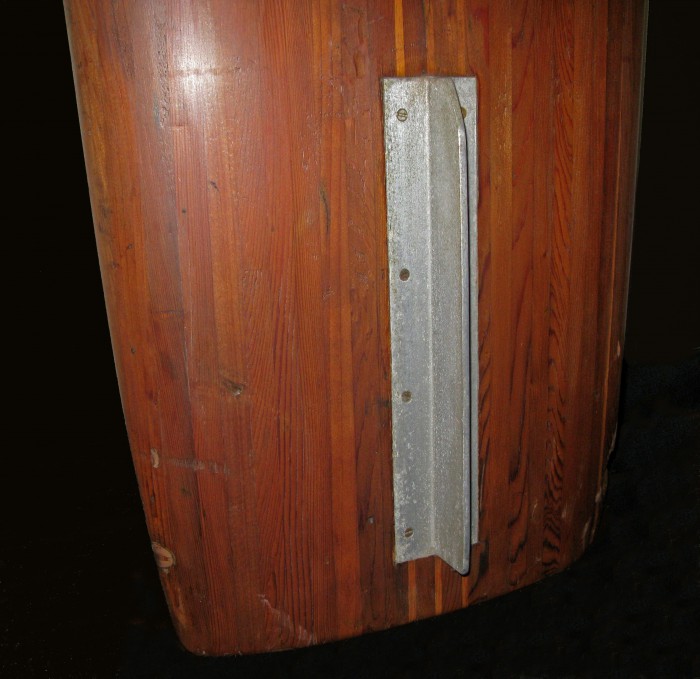
Solid wood board with aluminum keel fin (late 1930’s) Surfing Heritage & Culture Center collection photo: Merson
The keel was 4” deep by 12” long and provided stabilization and control that was previously unknown to wave riders of the day. Woody Brown was also working on a fin at about the same time but Blake was the first to patent the surfboard fin. The new control that the fin afforded allowed the surfer to turn parallel to the face of the wave and hold a tight line without the tail sliding out.
The fin took a while to catch on, almost 10 years, but eventually everyone started carving fins from wood and attaching them to their boards. Tom Blake’s discovery and application of the fixed fin was the greatest design contribution in performance surfing and opened the door to all the possibilities that the modern surfer enjoys today.
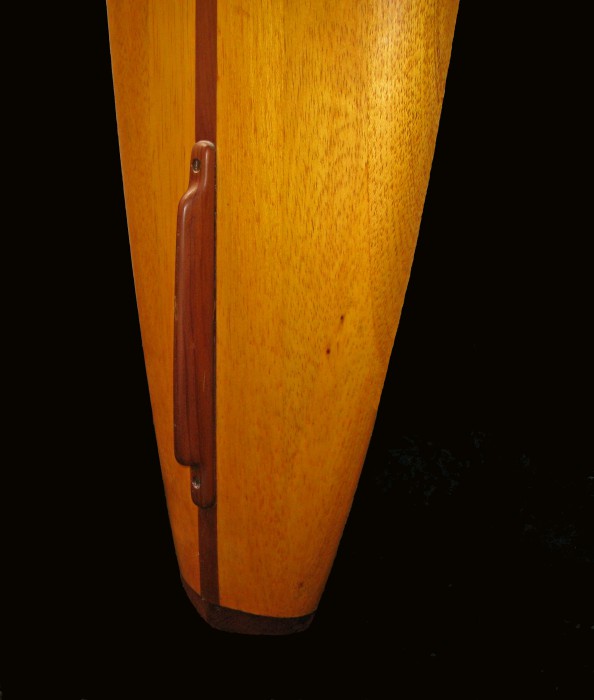
Hot Curl board with early fin (late 1930’s) Surfing Heritage & Culture Center collection photo: Merson
The wood fin gained popularity throughout the 1940’s but there was not much innovation or design change. The fin remained a low profile keel usually 4” to 6” deep and about a foot long. When the fin was added to a hot curl board they out performed Blake’s hollow boards.
The next big design innovation in surfing came in the mid 1940’s with major design contributions by Bob Simmons. Bob started building his own boards in the early 1940’s, solid planks similar to what was popular at the time. He was not a fan of Blakes boards and always referred to them as paddleboards. He studied hydrodynamics and the use of fiberglass and resin, materials that had been used in the war, and by the mid 1940’s he was building boards that eventually would revolutionize surfing. Bob made the first lightweight boards with a foam core sandwiched between plywood veneer, balsa wood rails and wrapped in fiberglass and resin. He designed the first planning hulls and eventually developed rocker, thinner noses and tails, modified hydro foiled rails and concave bottom contour in the tail.
Bob was the first to use dual fins on a surfboard. (There is a picture of Tom Blake standing in front of a dual finned board circa 1943 but nothing is known of the board. Probably a one off experiment.) The tails of his boards were wide and he placed a small fin on each rail at the tail and towed them in 10 degrees. Eye witnesses and test pilots of the day claimed the new boards to be faster than any surfboard in the water. When Simmons died in 1954 in a surfing accident at Windansea no one carried on his work and design concepts. Bob Simmons first twin fins propelled surfing toward the modern age but it would take decades before anyone realized how important his contributions had been.
Californian Joe Quigg started making light-weight balsa and redwood boards around 1947. He, like Simmons, used Malibu as his test track. Joe was one of the first to incorporate rocker in his boards. He shaped the first pintail boards and narrow big wave guns. Quig pulled in the tail and shaped hydrodynamic rails, designed by Simmons, and added rocker to allow his single fins to perform better. He made significant design contributions to the fin by producing the first all fiberglass fin and narrow based long raked-back fins. He is also said to have been the first to put three fins on a surfboard.
Hawaiian George Downing was an early big wave rider and designed some of the first big wave boards that came to be known as guns.
He also had a huge influence on the evolution of the fin by inventing the first fin box for a removable fin in the early 1950’s.
“In the early days I didn’t know quite where the optimum place was to position my fin. I couldn’t keep glassing my fin on, then remove it, and re-glass it…that was a pain in the ass. So I began thinking of some way I could attach my fin to my board without having to glass it on. Knowing about sailboats and the different wood used for sailboat construction, I made the first fin box out of wood with a groove in it so you could take the fin in and out, plus it would enable me to experiment with different size fins. The only problem with my fin box design was I had no way of securing the fin tight to the box. By making the box out of teak wood, made it perfect for ocean use. I used a piece of cardboard to secure the fin tight against the wood before I paddled out. Unless somebody invented the fin box before me, mine is the first one in history. I still have the original balsa wood board I installed it on.” — board circa late 1940s, fin box added in the early 1950s Ocean Magazine
After the death of Bob Simmons the single fin longboard era began. Balsa wood was the material of choice for surfboard shapers from the late 1940’s through the mid 1950’s. The balsa cores were wrapped in fiberglass producing a strong yet fairly lightweight board. They became known as Malibu chip boards.
As surfing gained popularity and the demand for surfboards grew the shapers had a harder time finding enough high quality balsa wood. In the mid 1950’s Hobie Alter and Dave Sweet were independently experimenting with polyurethane foam as a replacement for balsa wood as the core material. After a few years of development and trial and error the foam blank was perfected. It was lighter and much easier to shape than balsa wood and it could be created on demand. By the 1960’s the balsa wood boards had all but disappeared. Everyone wanted the lightweight foam and fiberglass boards. During this time the surfboard fin was made of wood covered with fiberglass or all fiberglass. The fin had grown in depth from the low profile fins of the 1940’s.
The deeper fins added more stability and combined with the new lighter boards, made tighter turns possible. At the time they were referred to as skegs not fins. The most popular fin or skeg of this era was often called the “D” fin. There was not a lot of experimentation with fin design at this time. There were a few exceptions like the “reverse skeg” and a more raked back design referred to as a “speed skeg”.
In 1952 Dale Velzy made the Vee fin which was actually two fins joined together at their base, to help hold the board in the face of the South Bay beach-break waves.
Almost all of the design and creativity of the wood fins were all show and no go. There were sunburst patterns, checker boards and stripes but not much change in the templates.
Through the early to mid 1960’s fiberglass fins gained in popularity and there were a few more styles and templates to choose from. A lot of the design input was directed toward developing a fin that would enhance the nose ridding capabilities of the board. These fins generally had greater depth and larger surface area at the tip.
Dewey Weber had his “hatchet fin”, Greg Noll had a rectangular fin, Carl Ecksrom developed the “bat fin”, Bing came out with the Nuuhiwa Noseridder model with a mild cutaway and raked fin, and there were many others. There were also surfers and shapers looking to improve on the turning capabilities of the mid sixties long boards. The cutaway raked back fins started appearing around 1964 and elevated the boards to a new level of performance.
One of the most popular boards of that era was Mike Hynson’s Red Fin model by Gordon and Smith. In 1965 Hynson introduced the dorsal red fin and then in 1966 he refined his design to a more raked back cutaway version. Other popular cutaway finned boards were Harbour’s Trestles Special, Hanson’s 50/50 model, Hobie’s Phil Edwards model, Morey Pope’s John Peck Penetrator and many others. In 1966 Greg Noll introduced the Micki Dora “da Cat” model with a removable raked back cutaway fin and fin box.
The removable fin dates back to the early 1950’s however they were not commercially available and were only used by a handful of surfers. Tom Morey, with an aerospace engineering and composite background, was an early manufacturer of a removable fin system in the mid 1960’s. Tom Morey’s Skeg Works made the first commercial polypropylene fin boxes and removable interchangeable fin system, TRAF (“fart” spelled backwards). In 1966 Morey improved his design with the Wonder Bolt system. Polypropylene became a popular material to mass-produce fins from during this time although they proved not to be as durable as fiberglass, having issues with sun damage. This was the high performance long board era but surf design was about to change dramatically.
George Greenough was born and raised in the Santa Barbara area. He started surfing on the traditional long boards of the day but did not like anything about them. In 1962 he shaped a short board in the 7 foot range.
The shorter board performed better but he soon discovered that he wanted to ride closer to the water. Later that year George shaped a balsa kneeboard with a scooped out deck and that was the end of his stand up surfing. He made his biggest design contribution to surfing with his development of the flexible high aspect ratio fiberglass foiled fin. High-aspect is an aerospace design term that describes reduced resistance by reducing the fin area while increasing lift. His design was based on the tail fin of a tuna.
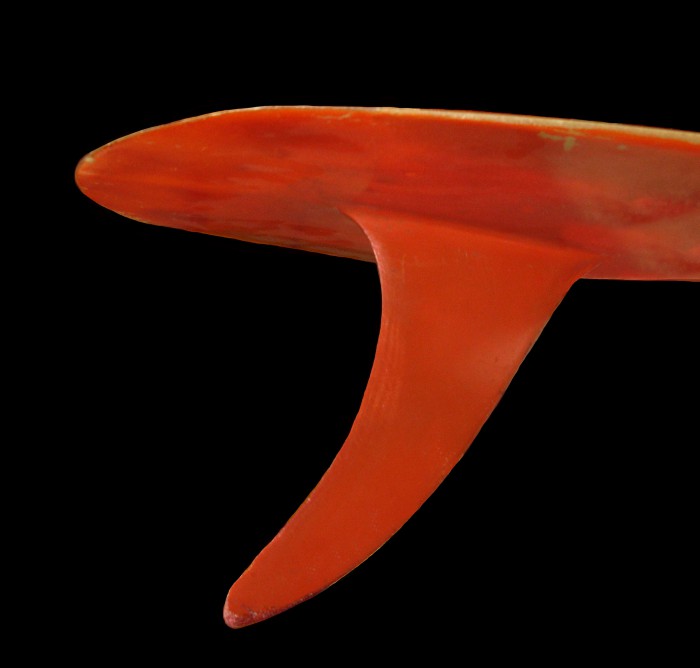
George Greenough, Velo fiberglass kneeboard with flex fin (mid 1960’s) Surfing Heritage & Culture Center collection photo: Merson
The performance improvement in speed and turning was so dramatic that it was the basis for all of his future projects. Greenough experimented with flexible fins over the next couple of years. He was so pleased with the results that he started thinking about building a board that flexed like his fin, allowing the board to move as it rode the wave just as a fish moves through the water. In 1965 he made Velo, his first flexible spoon kneeboard driven by an 11” high aspect ratio fin. Greenough went to Australia in 1965 and met up with Bob McTavish and Nat Young. When they saw the way George and Velo accelerated out of turns and surfed the waves in a way they had never seen before, they were inspired to change their own thinking and equipment.
When Greenough explained to them how the fiberglass foiled fin flexed and loaded up torque then exploded out of the turn, they started imagining what it would be like with George’s fins on their surfboards. McTavish, an accomplished shaper, went to work redesigning the surfboard. He shortened the board slightly at first, thinned out the rails and added a “V” bottom and one of George’s fins.
In 1966 after seeing some of the new concepts that Mctavish was experimenting with Nat Young shaped a new board that would come to be known as Magic Sam. Sam was a little shorter than the average long board of the day at 9’ 4”. The biggest difference was in overall thickness, 2 ½” when the average boards were over 3”, and thin tapered and softly rounded rails. Nat’s design was aimed at making a board that would turn better. Sam started life with a fuller traditional fin of the day. After riding it a bit the fin was modified by George Greenough and Nat into one of the high aspect ratio profiles that George had been using on his boards. Nat went to San Diego for the World Contest where he and Sam carved circles around the traditional nose riders, won the contest and opened the eyes of the surfing world to the possibilities that lay ahead. This was the beginning of the short board revolution. Once it started the boards just kept getting shorter and shorter however the real first step was Greenough’s breakthrough fin design. Maybe instead of short board revolution it should have been called the fin revolution.
In 1968 Tom Morey improved on his original interchangeable fin system and with new business partner Karl Pope introduced the Wave Set removable fin system with a variety of interchangeable molded fins. The Wave set system had fins designed by George Greenough, Skip Frye and others.
Greenough offered Stage I, III and IV designs. Frye’s small New-e-Free design focused on sideslipping. The Wave Set system was offered to board manufacturers as a step up option and became very successful throughout the late 1960’s. As boards got shorter the bulky box was modified with a notched male fin base that locked into a molded female box.
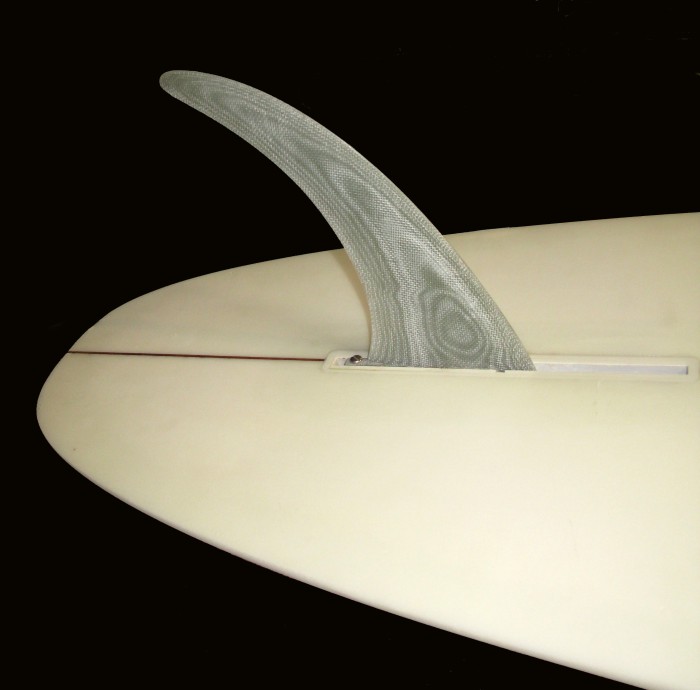
Greg Liddle hull with removable fiberglass flex fin, Surfing Heritage & Culture Center collection photo: Merson
In 1964 Bill Bahne started Fins Unlimited to address the needs of surfers desiring a removable and adjustable fin system. In 1968 Bahne applied for a US Patent for the “Adjustable Surfboard Fin Holder” or the fin box as it came to be known. The patent was granted in February 1971. Bahne’s fin box design was readily accepted as the industry standard. Much of the success was attributed to the fact that the box could accept a wide variety of laminated fiberglass fins.
Most surfers considered fiberglass fins superior to the molded plastic fins. A single fin box and a single fin was the only choice throughout the 1960’s.
The earliest documentation of a twin fin first appeared in 1943 on a board possibly made by Tom Blake. In 1948 Bob Simmons started making twin keel fin boards and they were considered by their riders as the top performing boards of the era. Steve Lis was a knee boarder in La Jolla, California. Lis is credited with the development of the twin fin fish design in 1967 that is still very popular today.
The Lis twin fin design drew a lot of attention in the late 1960’s. At the same time twin fins were being developed in Australia and after the 1970 World Contest in Victoria several U.S. board builders jumped on the twin fin band wagon. One of the first was Bing with a Mike Eaton designed wide tailed twin fin for World Champion Rolf Aurness. Surfer David Nuuihwa experimented with shorter designs, Terry Martin at Hobie Surfboards shaped boards for Corkey Carroll and others. By 1971 most board manufacturers offered a twin fin in their line up. Some worked and some didn’t. The problem was in figuring out the fin placement, toe in, cant and template. They didn’t work well in larger more powerful waves and after a couple of years most lost interest in the design.
Steve Lis’s fish design caught the attention of stand up surfers in southern California.
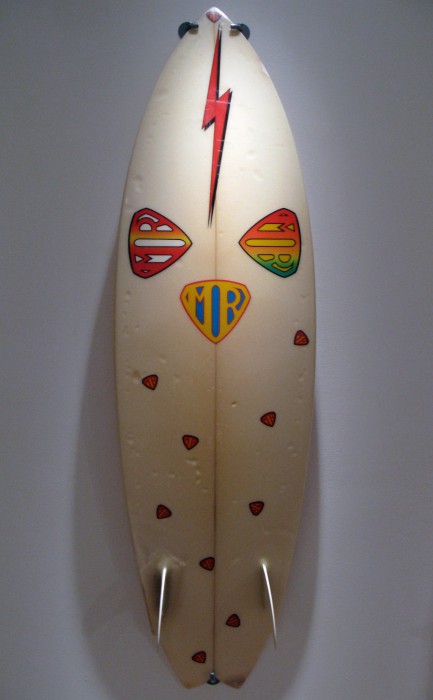
Mark Richards MR Twin Fin (late 1970’s) Surf Craft exhibit Mingei International Museum photo: Merson
A longer narrower board was developed in 1974 with a swallow tail and became known as the “Rocket Fish”. Carl Hayward, Clyde Beatty and Steve Brom were early rocket fish pilots and shapers. In 1976 Australian Mark Richards, influenced by a small twin fin designed by Hawaiian Reno Abellira, started working with shapers Dick Brewer and Ben Aipa on a new twin fin swallow tail design. After much refinement the new design worked well in larger surf as well as small surf. Richards rode the new MR twin to several contest wins and the World Title in 1979.
Gordon and Smith Surfboards made Mark Richard models under license in the U.S. and were available with Star Systems fin boxes. Variations of the new twin fin design soon became available from all manufacturers and were the popular choice from 1979 thru 1981.
While variations on the fish design gained popularity throughout the 1970’s, in out of the way Oxnard California, two teenage brothers, Duncan and Malcom Campbell were being very creative. The Campbell brothers were riding short 5’6” to 5’8”, wide tailed Australian influenced single fins. The brothers felt that the short boards did not provide the drive or speed needed when the waves were larger and more powerful. It was their father who first came up with the idea of three fins. After doing some research on boats and hydrodynamics they settled on a stretched out triangular shaped keel about 10” long. The keels were mounted just off the rails ahead of the center fin. For the next couple of years they refined the design. The bottoms started off flat at first and then evolved into the single to double concave tails that the Bonzer became known for. The boards worked really well but no one outside of Oxnard new about them. The Campell brothers sent letters and pictures to several board manufacturers and magazines.
Bing responded in a week and set up a meeting. After discussing the design merits and watching some film footage, Bing and lead shaper Mike Eaton acknowledged that the boards worked. In 1973 Bing started producing Bonzers and kicked off an ad campaign. The publicity helped to sell some boards but the design never became mainstream. Bing sold his company to Gordon and Smith in 1974 and the new powers to be never got behind the Bonzer. The Campbell brothers ended the relationship and went back to making their own boards. Several pro surfers found success riding Bonzers including Terry Fitzgerald, Peter Townend and Ian Cairns. The Campbell brothers kept refining the design but the boards did not have much of a following probably because for shapers at that time the concaves were difficult to get right and the keel side fins had to be custom made.
In 1980 Australian pro surfer and shaper Simon Anderson was getting frustrated with contest surfing in small waves. He was going back and forth between a twin fin in small surf and a single fin in larger surf. He was struggling to find a board that worked well particularly in 2’-4’ surf. Simon saw a friend, Frank Williams, ridding a twin fin with a small trailing center fin which made the twin fin design more stable. It was at that moment that Simon decided to make a three finned board with a full sized fin on the tail for stability.
The board worked great and in 1981 he won the Bell’s Beach Classic, Coke Surfabout and the Pipeline Masters on his 3 fin thruster. Within a couple of years the 3 fin thruster became mainstream and dominated the surfboard market. Today, over 30 years later it is still the most popular board design for pros as well as recreational surfers. What is amazing is that in 30 years Simon has only moved the fin placement an 1/8”. The original Thruster design was pretty much right on target.
It’s hard to pinpoint who was the first to place 4 fins on a surfboard. In a recent communication from pro surfer and shaper, Greg Mungal, it is evident that he was clearly a very early adopter.
Just wanted to let you know I developed the first Quad in 1979/1980 while surfing for Nectar surfboards. How, because Simon, my teammate invented the tri fin and Gary McNabb wouldn’t allow me to incorporate a 3 fin to my already single and twin fin models. Gary,said, well put on four and I did. Just for your information.
Best regards,Greg Mungall
In the early 1980’s pro surfer and shaper Glenn Winton was another of the first to develop the 4 fin “quad” design. Winton found the center fin on the thruster to be restrictive and made the board slow in small waves. He replaced the center fin with a pair of small twin fins at the back of the board. Winton was successful with a quad on the pro tour and there was a great deal of interest in his quad design.
Another early quad surfer and designer was Rusty Preisendorfer. Rusty believed the quads were faster, looser, rode the barrel higher and tighter, accelerated better on cutbacks and drew new and different lines than the thruster. Australian Bruce Mckee has been designing quads for decades. He made Kelly Slaters 2012 Trestles contest winning board as well as boards for Tom Curren, Tom Carroll, Mick Fanning and Joel Parkinson. Mckee makes quad shortboards, longboards, guns and tow in boards. Mckee calls his boards “Quattro” and is quick to share his knowledge about the superior performance aspects of his design over the thruster. Even though the thruster has been the most popular board for the past 30 years there are many creative designers offering exciting alternatives.
In 1983 the Campbell brothers built the first 5 fin Bonzer. Based on the same principals as their earlier 3 fin design, the 5 fin broke up the side fin area differently. The improvement in performance was dramatic especially in larger more powerful surf. The 5 fin design won over many new converts to the Bonzer camp and the popularity in this revolutionary design continues to grow to this day.
In 1990 one of the biggest innovations in modern surfboard design was the invention of the plug changeable fin system first pioneered by FCS (fin control system) and patented in 1995. Most shortboards had glassed on fins which left little room for fin experimentation other than a little sanding or re-shaping of the template and foil.
The plug systems allowed for easy fin replacement and opened new doors for innovation and board tuning. It didn’t take long before there were many manufacturers making changeable fin systems such as Futures, Lokbox, O’Fish’L, Probox, Red-X and more.

